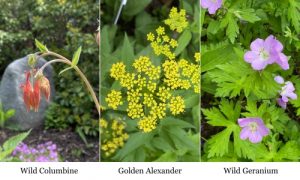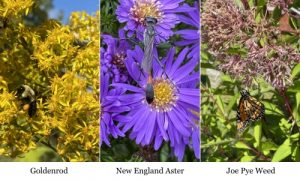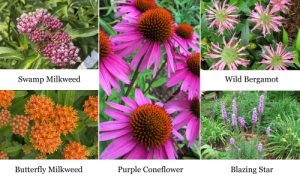(by Diane De Luca)
Step Two: Go Native!
Native plants provide the best food and shelter for local pollinators because they have evolved alongside them for thousands of years, creating a mutually beneficial relationship. They offer the ideal nectar and pollen sources that bees, butterflies, and other beneficial insects rely on.
Additionally, native plants support the full cycle of pollinators by providing not only food but also essential habitat for nesting, overwintering, and reproduction. Adapted to the local climate, they require less water, fertilizer, and maintenance than non-native species, making them a more sustainable and environmentally friendly choice. By planting native species, you help restore natural ecosystems, promote biodiversity, and create a thriving habitat for pollinators. (If you’re unsure where to find native plants, visit NH Audubon’s Annual Native Plant Sale this June. Bagley Pond Perennials and Fassett Farms will be offering a wide selection of native plants and shrubs for purchase and you can speak with our expert staff and volunteer Pollinator Garden team.)
Suggestions for Key Northeast Native Plants

- Wild Columbine (Aquilegia canadensis): Provides early-season nectar for hummingbirds and native bees.
- Golden Alexander (Zizia aurea): Blooms in mid-spring and attracts bees and butterflies, serving as the host plant for the Black Swallowtail.
- Wild Geranium (Geranium maculatum): Attracts a wide variety of pollinators including bees and butterflies
- Swamp Milkweed (Asclepias incarnata) and Butterfly Milkweed (Asclepias tuberosa): Vital host plants for Monarch butterfly caterpillars and excellent nectar sources for adult butterflies.
- Purple Coneflower (Echinacea purpurea): A favorite of native bees, butterflies, and other pollinators. Its vibrant blooms provide nectar, while its seed heads offer food for birds in the fall.
- Wild Bergamot (Bee Balm) (Monarda fistulosa): Attracts hummingbirds, native bees, and butterflies with its fragrant, lavender flowers.
- Blazing Star (Liatris spicata): A striking addition to gardens that supports butterflies and native bees with its purple spikes of flowers.

- Goldenrod (Solidago spp.): An essential late-season nectar source for migrating Monarchs and other pollinators. It supports a diverse array of native bees and beneficial insects.
- New England Aster (Symphyotrichum novae-angliae): Provides critical late-season nectar for bees, butterflies, and migrating Monarchs. Often paired with goldenrod for a colorful fall display.
- Joe Pye Weed (Eutrochium maculatum): Tall, nectar-rich blooms that are magnets for butterflies, especially Swallowtails.
Additional Suggestions for Diversity:
Here are some excellent resources to help you find native plants in the Northeast:
- Native Plant Finder by the National Wildlife Federation
- Enter your zip code to get a list of native plants that support the most butterflies and moths, essential for pollinators.
- Audubon Native Plants Database
- Find bird-friendly native plants specific to your area. This tool also includes information on the types of pollinators they support.
- Plant Native
- Offers lists of native plant nurseries by state, making it easy to find local sources.
- Pollinator Partnership’s Ecoregional Planting Guides
- Download free planting guides tailored to your ecoregion for pollinator-friendly landscaping.
- Xerces Society’s Native Plant Lists
- Provides regional plant lists focused on supporting pollinators and beneficial insects.
Important Tips
- Plant in Clusters: Group 3-5 plants of the same species together to make it easier for pollinators to find and feed.
- Provide Continuous Blooms: Select a variety of species to ensure blooms from early spring through late fall.
- Skip the Pesticides: Avoid using harmful chemicals that can harm pollinators and beneficial insects.

